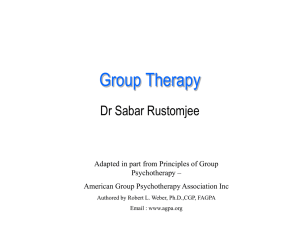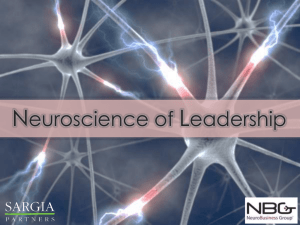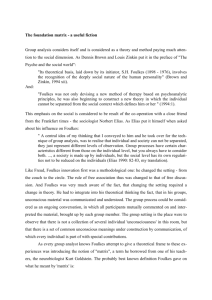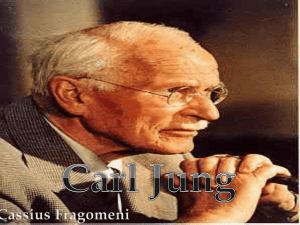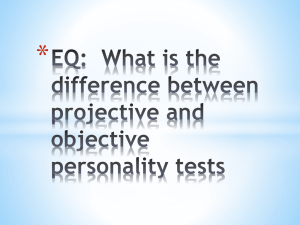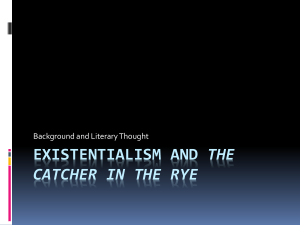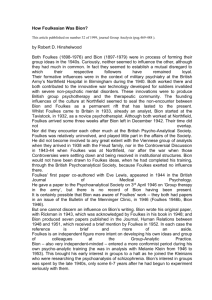On the Social Unconscious - Australian Association of Group
advertisement
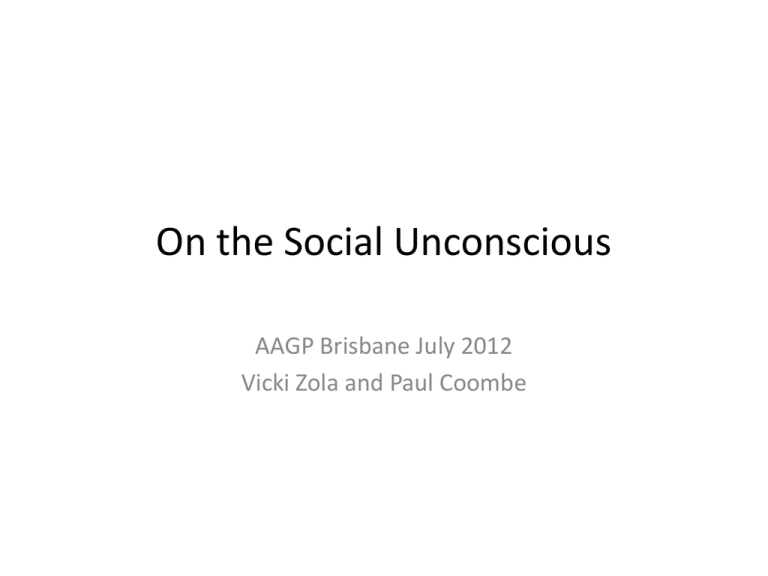
On the Social Unconscious AAGP Brisbane July 2012 Vicki Zola and Paul Coombe Introduction • On Saturday 28th July 2012 Paul Coombe and Vicki Zola presented to the Brisbane meeting of the Australian Association of Group Psychotherapists their review of aspects of the current state of the concept subsumed under the title of the “Social Unconscious”. What follows are the paired power-point presentations of each of the presenters beginning with that by Paul Coombe and concluding with that by Vicki Zola. Further information may be obtained by contacting either presenter whom are both members of the AAGP. Definition? • Multiple definitions which will be described as we proceed but it is useful to understand that Foulkes used the term quite early. • Foulkes makes mention of the “Social Unconscious” in the book Group Psychotherapy published in 1959 by Foulkes and Anthony.: “There is the opportunity(the group) affords for the exploration of what may be called the ‘social unconscious’. Each individual’s feelings and reactions will reflect the influences exerted on him by other individuals in the group and by the group as a whole, however little he is aware of this. The small therapeutic group also represents for its members other people, in general, or even the whole community....”(p. 42). Some Early Ideas: 1: .Freud: – “Totem and Taboo”: 1912-13: The Primal Horde(also Darwin)/Religion eg. Christianity-the Communion(eating the father symbolically in communion: the body and blood) etc. ie. “...the killing of the chief by violence and the transformation(through cannibalism) of the paternal horde into a community of brothers.” – .“Group Psychology and the Analysis of the Ego”: 1921.: “..the psychology of groups is the oldest human psychology...”. And: “...The primal father is the group ideal, which governs the ego in the place of the ego ideal...”). What binds the members of a group is identification with the leader: all come to share the same ego-ideal. – Superego; “The Ego and the Id”: 1923: parental etc. influences. (origin of guilt lies in parricide by sons and the taking of women for themselves...) Early Ideas continued: 2. .Jung: “The Collective Unconscious”. .“Neo-Freudians”: referring to American theorists such as Karen Horney, Erich Fromm and Harry Stack Sullivan who attempted to re-state Freudian theory in sociological terms rather than biological. .Melanie Klein: Object relations theory: internal objects exist in the internal world that have relationships with each other. They are a product of the innate instinctual inheritance and also internalizations of part and whole objects. So in a sense the external world in part comes to be located internally though changed by splitting, projective and introjective processes. Early ideas: 3. • Bion: Container/Contained implies a social connectedness; Basic Assumption Groups are regressive experiences away from the “work” and are expressions of the unconscious life of a group. • Winnicott: There is no such thing as a baby only a mother and baby. Intersubjectivity and transitional space are introduced as key concepts but largely in the dyadic relationship of mother and baby although the father is given a role(to support the mother in her developing connection with the infant). Foulkes: 1 The Matrix • P. 292 Therapeutic Group Analysis(1959). • “The Matrix is the hypothetical web of communication and relationship in a given group. It is the common shared ground which ultimately determines the meaning and significance of all events and upon which all communications and interpretations, verbal and non-verbal, rest.” • It is also referred to as the “Group Dynamic Matrix”. Foulkes: 2: The Foundation Matrix. • P. 131-2 Group Analytic Psychotherapy: The Foundation Matrix(1975). • Foulkes sees this as based on the biological properties of the species and also on the culturally embedded values and reactions developed and transmitted in the nuclear family, social network, class etc. and that have been maintained by the network in which the person inhabits. Foulkes: 3. The Foundation Matrix (cont.) • Foulkes does not seem to ever elaborate in any depth on what he means by the term Foundation Matrix but others have. For example, Hopper and others see it as including the social, cultural, communicational and political arrangements and constraints of the society as a whole, if not the world, or all the social systems within which a group exists. It includes language, social stratification, gender roles, class etc and implies transgenerational processes. Foulkes: 4. (1964): Levels of Relatedness and Communication of the Individual within and with the Group. • 1. The Current level: level of everyday current relationships – of social relationships and sociology; • 2. The Transference level: displacing internal object relationships outwards; • 3. The Projective level: projected and shared feelings and phantasies, often bodily. • 4. The Primordial level of the collective unconscious, shared myths, archetypes, etc. ie. elements of the “foundation matrix”. • “Foulkes’s view of group dynamics and the relationship of the individual to the group is very much a communicational one.” Brown(2001) Dennis Brown 2001: 4 Ways in which the Social Unconscious is Manifested: • 1. Assumptions: what is taken for granted in our society eg. that we should not eat food with our hands or that we are naturally superior or inferior to others. • 2. Disavowals: disowning knowledge or responsibility for things that are unwelcome eg. greed or envy to prevent guilt. • 3. Social Defences: what is defended against by projection, denial, repression or avoidance; ridding ourselves of what we do not like or cannot bear about ourselves; the organization of social systems to diminish anxiety: Menzies-Lyth(1961); “us versus them”. • 4. Structural Oppression: control of power and information by competing interests in society and the international community ensuring awareness is restricted eg. racial prejudice and disadvantage; in Australia the plight of Aborigines, the poor, the exploitation by the mining industry of the “country”. Weinberg(2007 Group Analysis) • Presents a review of the theory. • His definition: • “...the co-constructed shared unconscious of members of a certain social system such as community, society, nation or culture. It includes shared anxieties, fantasies, defences, myths, and memories. Its building blocks are made of chosen traumas and chosen glories.” • It is NOT the superego • It is NOT the social in the individual unconscious • It is NOT the collective unconscious • It is NOT just hidden cultural norms Farhad Dalal: A Post-Foulkesian Perspective; 2001. • Psychoanalysis • Orthodox Foulkes – There are in a sense 2 group-analytic theories: “Orthodox” Foulkes and “Radical” Foulkes. The orthodox model is really what Foulkes enunciated originally in his famous publications and involves strong links with individualism and instinct-based theories. Orthodox Foulkes does talk about the Social Unconscious(see above) but retains the presence of the Freudian Unconscious and distinguishes between them both(p 542 Dalal 2001). “Thus the phrase ‘social unconscious’ suggests the presence of an unconscious that is NOT social or prior to the social or outside the social in some way.” According to Dalal orthodox Foulkesian concepts are found embedded in the work of Volkan, Brown and Hopper and he wants to break away from these. “Radical Foulkes” • Radical Foulkes Foulkes’ later or more “radical” ideas are demonstrated in this quote: “…(the) group, the community, is the ultimate primary unit of consideration, and the so-called inner processes in the individual are internalizations of the forces operating in the group to which he belongs.(1971: 212). According to Dalal, radical Foulkes is saying: “that things that look like instincts…are internalizations of group forces…and that the id itself is acculturated.” Dalal is also saying that we cannot speak of there being 2 parts of the psyche one personal and one social. Vamik Volkan: Transgenerational Transmission of Chosen Traumas and Chosen Glories: 1. • Erikson defined identity as “persistent sameness within oneself... And a persistent sharing of some kind of essential character with others. • Volkan: 2 aspects of identity: • 1. Core identity as per Erikson; • 2. An “outer” layer making up say our social identity including what might include a professional identity; he likens this to a looser layer like a tent providing large group identity. • Transgenerational transmission can occur from one individual to another and from one large group or society to another transgenerationally. Volkan 2 • “Foreign psychological genes” are “deposited” into the next generation and beyond especially if not mourned. • “Chosen traumas” are unconsciously selected eg. Germany and the third Reich and the Mitsscherlichs(1975). • Milosevic/Karadzic and the “Battle of Kosovo” on the 28th June, 1389. • Shakespeare: Henry 5th, 1599. • Australian Aborigines and the arrival of the First Fleet. Hopper: 1. Theory; GA; 2001. • “An analyst who is unaware of the effect of social events and social forces cannot be sensitive to their unconscious recreation within the therapeutic situation. He will not be able to provide a space for patients to imagine how their identities have been formed at particular historical and political junctures, and how this continues to affect them throughout their lives.”(1996) • An understanding of groups (and individuals) should always include an understanding of context; eg. referral networks, training systems, background of therapist etc. Hopper: 2 • “The concept of the social unconscious refers to the existence, and constraints, of social, cultural and communicational arrangements of which people are unaware. Unaware, in so far as these arrangements are not perceived or known, and if perceived not acknowledged(ie. “denied”), and if acknowledged, not taken as problematic, and if taken as problematic, not considered with an optimal degree of detachment and objectivity.” Hopper: 3 • “Equivalence”: people tend to unconsciously recreate and repeat situations that have occurred in the past and in another place(time and space). The repeated can be seen as “equivalent” to the other or older one. • Equivalence reflects the social unconscious and uses externalization/internalization and projective/introjective identification in order to communicate(as well as expel). • A form of group transference. Hopper has more theoretical allegiance to Foulkes than Bion but recalls Bion’s words in Experiences in Groups(1961): the basic assumption group knows no time and knows no space. Time: now and then; Space: here and there. Hopper: 4 Communications between analyst and patient/group are considered in terms of 4 cells: Hopper: 5 • The “here and now” cell refers to an important area where transference is encountered and it is essential to work within this area. • The “there and then” cell refers to the relatively neglected focus in analytical work that Hopper believes should be addressed and that involves the social unconscious. Hopper: 7 • In summary Hopper believes that the therapist’s interventions need to include reference when it can be made to the social, cultural and political within sessions not just internal realities. Also, that interpretations should not just focus on the mother or father transferentially but draw on the wider social reality. • According to Hopper our role in working analytically with groups is to not only help people develop an understanding of their psychic reality but also their social reality.
